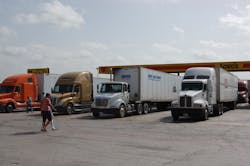Job posting data collected and analyzed by CareerBuilder indicates a strong and steady gap between the availability of truck driver positions and actual hires to fill them has developed over the last year and should continue for the foreseeable future.
Data from CareerBuilder’s transportation-focused JobsInMotion.com site analyzed by the firm’s Economic Modeling Specialists (EMSI) division indicates that from August 2013 through July 2014, the trucking industry managed to hire an average of 131,000 candidates per month to fill some 298,000 unique monthly job listings for truck drivers.
That’s an indication many available truck driving jobs are likely remain open for extended periods of time, according to Ryan Hunt, corporate communications manager for CareerBuilder.“Beginning about a year ago, we started seeing a massive spike in unique postings [yet] the hire rate has remained steady at about 120,000 to 130,000 a month,” he told FleetOwner. “This indicates increased demand for drivers without a subsequent increase in supply.”
That’s borne out by another JobsInMotion data point: since 2010, the truck driver profession has grown 7.8%, which is faster than the overall 5.5% growth rate for all U.S. jobs over that same four year span.
Moreover, Hunt noted that 56% of the 1.8 million heavy and tractor-trailer truck drivers employed in the U.S. – an occupation accounting for 23% all transportation-related jobs in the nation – are 45 or older. Thus as more workers in the profession retire, replacing them could continue to prove difficult.
“Anecdotally, we’re hearing that the Millennial generation does not view this [truck driving] as an attractive profession – even though wages are on average higher for truck drivers compared to other transportation jobs,” he said. “At the end of the day, it just means carriers need to compete harder to get drivers.”
Rob Morris, director of JobsInMotion.com, noted that median wages for truck drivers is ranging anywhere from $18 to $21 per hour, depending on the market, but such pay isn’t always enough to attract young drivers who are unwilling to sacrifice “work-life balance,” he said.
That’s echoed by the findings of a recent nationwide survey of U.S. truck drivers conducted by National Retail Systems (NRS) – the parent company Keystone Freight Corp. & National Retail Transportation as subsidiaries – which discerned that salary (43%) remains the top reason truck drivers leave their previous jobs, with home-time (28%) the second most common issue.
NRS’s poll also found that 42% of drivers apply for two to three open positions at a time when looking for a new job, with almost 8% noting they apply for more than 15 jobs at a time.
Another 42% of drivers participating in the company’s survey added that on average they’ve worked for three to five different carriers over the last decade.
“This shows just how in demand drivers are,” noted David Bullins, east coast recruitment officer for truck driver jobs at NRS. “They can work for a company, and if they aren’t happy with the color of their tractor or the tone of a dispatcher, it is as easy as going down the street to pick up a new job.”
“Employers have to do more to incentivize job candidates, whether that’s by offering signing bonuses and more generous compensation packages or by covering training and licensure costs,” stressed JobsInMotion’s Morris.
“Additionally, companies should be working closely with regional schools and CDL [commercial driver license] training facilities to build more recruiting pipelines and better market the profession,” he said.
About the Author
Sean Kilcarr
Editor in Chief
Sean Kilcarr is a former longtime FleetOwner senior editor who wrote for the publication from 2000 to 2018. He served as editor-in-chief from 2017 to 2018.

